Institute Celebrations of Spring
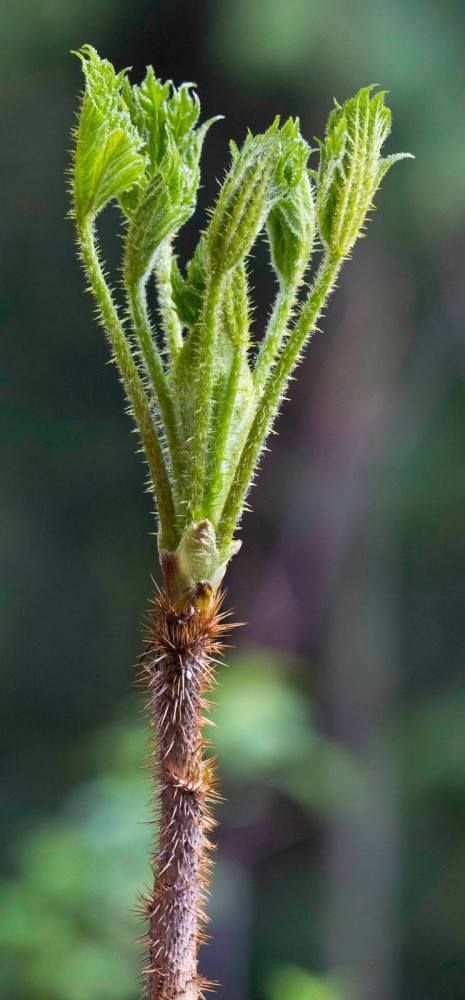
I think it may be safe to say that life is coming back to the North Cascades as of today, and yesterday, and even a few weeks ago! At first the change was so subtle it was barely recognizable, and we here at the North Cascades Institute were still clinging to the warmth of our down jackets even as the first shoots of palmate coltsfoot were pushing their way stubbornly through the matted duff of winter. Then the first familiar calls and presence of returning migratory birds were heard – the throngs of robins, the vibrant rush and resonate tapping of the red-breasted sapsuckers, the two-toned trill of the varied thrush, yellow warblers, and most recently the whir and brilliance of the rufous hummingbird. And now, with the warming and lengthening days, spring has truly taken off. Life is bursting everywhere from canopy to forest floor and an expanding color palette hints at more to come. Emergent alder leaves catch the growing sunlight and reflect it at new angles throughout the understory, delicate yellow violets line the edges of pathways, a few brave lady slipper orchids hide behind rocks, fiddleheads unfurl their fronds, and a solitary patch of bleeding hearts open their petals.
Each day, new anticipations. Each day, burgeoning new colors. Each day, returning signs of life to marvel at and explore.
Here at the Institute we each notice and experience these springtime harbingers in different ways. For some, spring’s arrival is primarily an auditory sensation captured in birdsong and flowing creeks, for others a visual experience of color, and for others still a feeling that sneaks up on them slowly or startles them into wonder at a particular moment – a waterfall swelling with snowmelt, sulfur butterflies basking in the sun on muddy trails, or the first black bear spotted as it munches feverishly on new shoots of grass and greens. Together, our collective celebrations paint a rich narrative of springtime in this place where we live, work, and play.
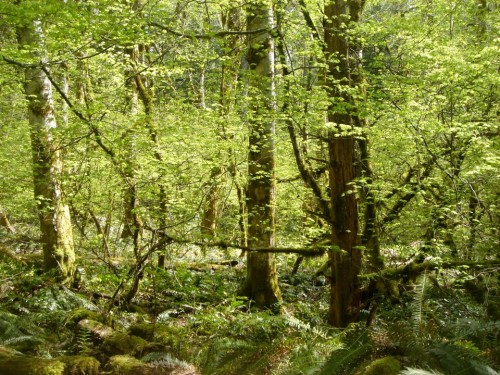 The dappled hues of green cast by sunlight on emerging alder leaves. Photo by Katie Tozier.
The dappled hues of green cast by sunlight on emerging alder leaves. Photo by Katie Tozier.
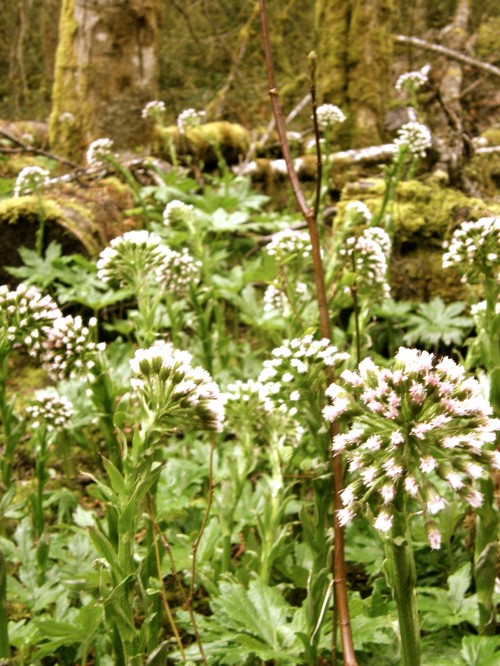 The bursting flowering heads of palmate coltsfoot. Photo by Christen Kiser.
The bursting flowering heads of palmate coltsfoot. Photo by Christen Kiser.
I love seeing this place come alive again! While I have appreciated the relatively warmer temperatures and opportunities to wear t-shirts and sandals, I have also loved seeing new life – the alder leaves budding, the ferns uncurling, grazing bears returning, and waterfalls growing. In the span of a week, I watched devil’s club grow six inches. SIX INCHES! Everything is clamoring its way to the sun and to new beginnings here in the Cascades. I feel inspired by spring. – Katie Tozier, Graduate Student
The Pacific Northwest spring is suspenseful, like listening to sustained discordant musical notes that find harmonic resolution only as the listeners are about to plug their ears in exasperation. Leaf and flower buds swell to start the buildup of tension. We wait for days, weeks – even months! – for distorted, underdeveloped leaves to relax into their full expressions. Finally, finally, they (and we) accept the reward for enduring the slow show by soaking up some sunshine. – Carolyn Waters, National Park Service Ranger
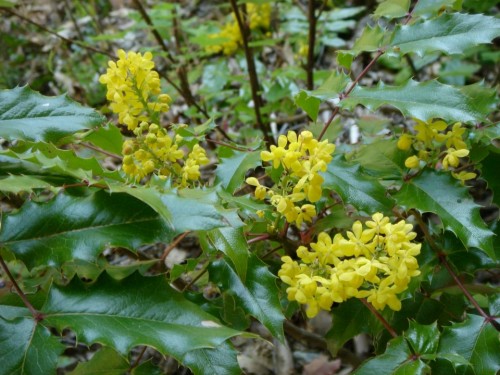 The yellow flowers of Oregon grape in first bloom. Photo by Katie Tozier.
The yellow flowers of Oregon grape in first bloom. Photo by Katie Tozier.
There are many delights with the coming of spring, but the most beautiful of them all is the emergence and fragrance of the first wildflowers. The Northwest forest is all too monochromatic for much of the year, expressing only variances of a single green hue. Now upon the spring forest floor one can find many shades of pink, yellow, and blue. Wildflowers are beginning to emerge from road sides and creek beds. Western trilliums (Trillium ovatum), Pacific bleeding hearts (Dicentra formosa), fairyslippers (calypso bulbosa), small-flowerd forget-me-nots (Myosotis laxa), swamp lanterns aka skunk cabbage (Lysichiton americanum), and yellow wood violets (Viola glabella) are some of the flowering friends you may find on the trails surrounding the Environmental Learning Center. Next time you are out on the trails keep an open eye and you are sure to be surprised by all the beauty you may find. – Matt Kraska, Stewardship Specialist
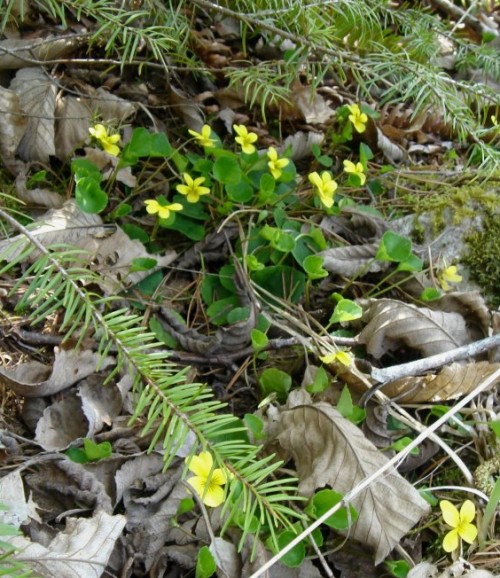 Yellow wood violets line the springtime trails at the Environmental Learning Center. Photo by Katie Tozier.
Yellow wood violets line the springtime trails at the Environmental Learning Center. Photo by Katie Tozier.
What delights me most about spring? I have two! My first delight is the arrival of the dainty yellow violets all along the sides of the Environmental Learning Center trails. The first pop of color other than green! The second is taking a walk and seeing the sun shining down through the newly-emerging vine maple leaves- it makes the forest canopy sparkle with new life! – Ashley Kvitek, Graduate Student
Spring means birdsong, schizophrenic weather, a million new shades of green, and baby bears… plus the magic of the annual unicorn migration. – Jeff Anderson, Science Coordinator
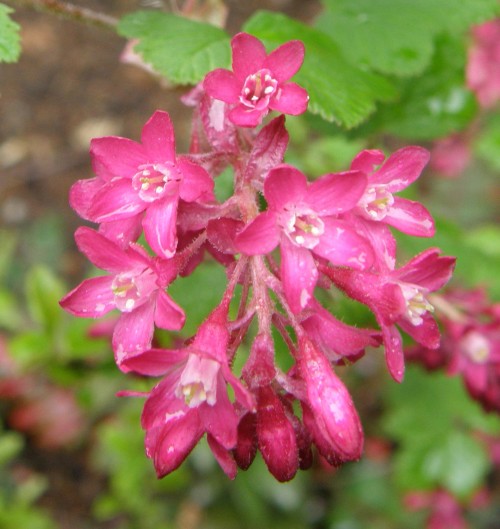 The elongated flowers of red flowering currant specially evolved to fit the long probiscus of the rufous hummingbird. Photo by Christen Kiser.
The elongated flowers of red flowering currant specially evolved to fit the long probiscus of the rufous hummingbird. Photo by Christen Kiser.
What delights me most about spring is noticing the earliest signs of the new season from the plant world – red flowering currant and salmonberry blossoms, horsetail and trillium, rhododendrons and daffodils – as well as the first hummingbirds visiting these brave blooms. I like to imagine the northward migration of hummingbirds up the coast, following the flowers as they emerge from winter’s sleep. – Christian Martin, Communications Coordinator
Over the past few weeks I have found that there is no shortage of signs that spring has arrived – from the appearance of the birds to the swatting of the mosquitoes, from the roaring of the creeks to the re-emergence of the bears, from the seventy degree days with bountiful sunshine to the spring rain showers, from the growth of new leaves to the first tiny flowers, the lengthening days to the rising water level of Diablo Lake – I have soaked up every minute of spring’s sweet arrival. – Sarah Bernstein, Graduate Student
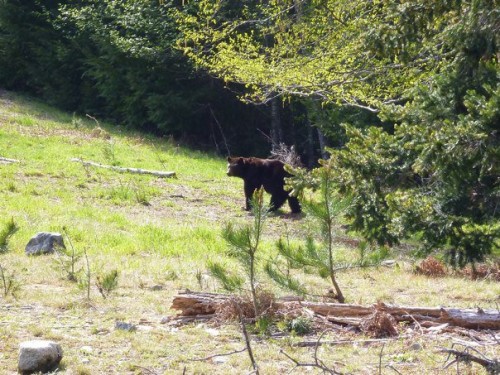 Our first returning black bear enjoying a hearty feast of grasses, sedges, and shrubs in Buster Brown field. Photo by Colby Mitchell.
Our first returning black bear enjoying a hearty feast of grasses, sedges, and shrubs in Buster Brown field. Photo by Colby Mitchell.
After being at the Environmental Learning Center, I can definitely say the sound of varied thrushes, and the antics of the rufous hummingbirds. Their predictable return, and especially the way the hummingbirds are so busy doing their hummingbird thing is inspiring. – Kate Rinder, Cascades Climate Challenge Lead Instructor
My spring highlights include lilacs – oh, the lilacs – the high energy of the birds buzzing and zipping around our heads, witnessing bare branches slowly turn into buds and starting to flower, the first sunny days with a warm breeze, the rainy days that let us appreciate those said sunny days, the overall “spring energy” from people coming out of their winter dens. – Jess Newley, Graduate Student
Leading photo of an opening devil’s club leave contributed by google images.


Thanks for all the perspectives! I’m going to have my students read this column for inspiration before our upcoming photography field trip in your area.
What a delightful perspective all of you bring! It is so nice to see and feel the appreciation for mother earth. This should be sent to all the schools that you teach for it is really inspirational. I love all the pictures, and of course especially the one of Christen in the next blog. Blessings, Lawrence